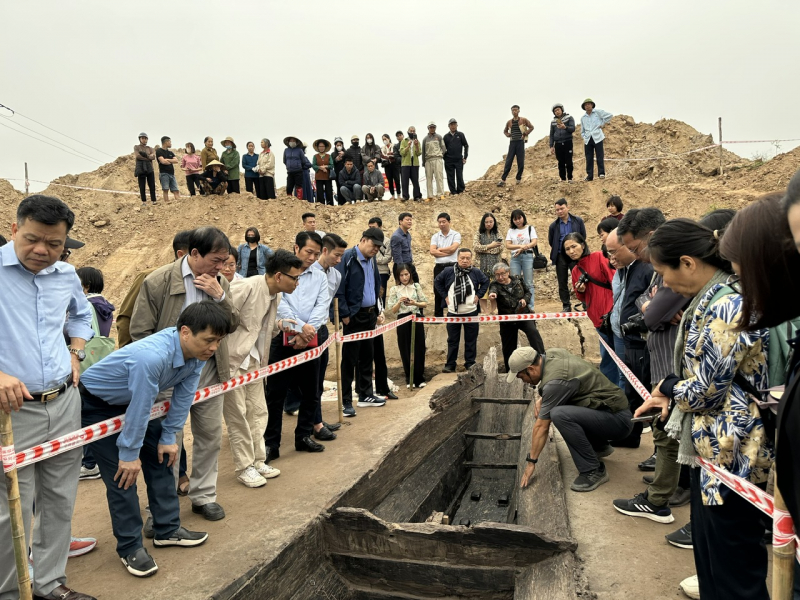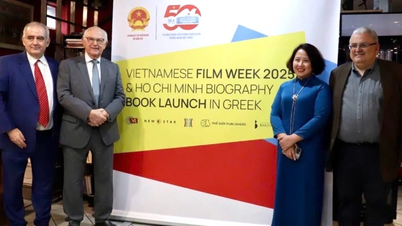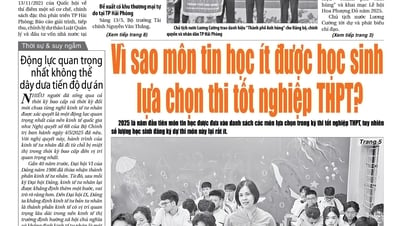1. In the report of the Department of Culture, Sports and Tourism of Bac Ninh, it is written: "The current state of the ancient boats exposed has a long direction in the East - West direction, lying parallel to each other in the North - South direction and about 2.3m apart (at the center position), the eastern part has exposed wooden bars connecting the two ends of the boat. Initial assessment shows that this is an ancient boat relic located on the Dau River, which is authentic evidence to assess the position and role of the Dau River in the historical flow with Luy Lau citadel and historical periods".

At the end of the report, the Department of Culture, Sports and Tourism of Bac Ninh wrote: "Continue to expand excavation and research to the entire Dau River space, study the scale and structure of the Dau River in the area where the relic was discovered, decode the location and role, and the transformation process of the Dau River in history".
Where is the ancient Dau River now, how wide is it, how it has changed... are still questions that cannot be fully explained in the field. Associate Professor Dr. Bui Minh Tri at the "shore" workshop cited the opinion of the late Professor Tran Quoc Vuong that the ancient Dau River is very wide, about 800m. That means it is still a "rough" number, an estimate, and cannot be measured in reality, or based on historical data. Therefore, when reading this report, a geographer said that the report of the Department of Culture, Sports and Tourism of Bac Ninh "the ancient boat relic located on the Dau River is authentic evidence to assess the position and role of the Dau River in the flow of history" needs to be considered, or to say that it is a bit early compared to the results of interdisciplinary and multidisciplinary research.
In addition, the report seems to have been written a bit too much when it stated: "After the emergency excavation period, the ancient boat relic has revealed all traces, through which the entire scale, structure, materials and manufacturing techniques of the boat can be identified". Reading this passage, those who have not been to the excavation site can be 100% sure, but many people who have "seen it with their own eyes" up to this point and the experts and researchers present at the "field" workshop are all... surprised. Because in reality it is not like that. If it is called "the ancient boat relic has revealed all traces", it must have been revealed from the inside out, from the bottom up with all the smallest aspects of the artifact. Meanwhile, with an emergency excavation period while emphasizing the factor of preserving the integrity of the artifact, the excavation team has only peeled off the upper part to clearly reveal the structure of the boat's bottom, while the two sides of the boat and between the two boats are still in the ground. Recently, the excavation team only opened a section on the side of the boat and discovered burn marks. This is to show that currently, only part of the traces of the two ancient boats or double-hulled boats have been revealed, the sides and bottom of the boat are still intact in the ground, the naked eye cannot see to visualize the entire trace.
2. Regarding the initial assessment of value, the report stated: From the scale, structure, construction techniques and materials, it shows that this is a type of double-hulled boat, the traces discovered at the scene are the two remaining hulls, this part in technical terms is called the water-retaining part, that is, the structure is completely submerged underwater, with the function of two buoys supporting the entire structure above. The structure above has been completely lost, possibly due to being dismantled. "This could be a boat with the function of transporting goods, but it could also be a boat used for river or river-sea excursions," the report stated. However, at the "shore" workshop, many other opinions also put forward hypotheses based on practical grounds, that with this structure and shape, it is highly likely that this is a boat used in some ritual practice. This is a distinct, independent assessment, not at all mixed with previous assessments. So why in its report, the Department of Culture, Sports and Tourism of Bac Ninh did not present an objective way for the provincial leaders to have a multi-dimensional view of the function of ancient boats? Up to now, the above assessment still has a small consensus among researchers. Therefore, the objectivity in the report has been somewhat hidden.
During the excavation, the artifacts and relics in the boat were quite diverse, including countless cardamom seeds, pottery, and wood. Currently, these artifacts and relics are in the process of research, waiting for the results to be announced. However, the report of the Department of Culture, Sports and Tourism of Bac Ninh did not mention the artifacts and relics contained in the boat. Meanwhile, the artifacts and relics found during the archaeological excavation are a type of document of special value, providing a lot of information about history, culture, ethnology..., especially contributing to determining the age. Dr. Nguyen Viet, who directly participated in the "field" workshop on the catamaran, highly appreciated the artifacts and relics found in the boat, and at the same time made important comments. In addition, he also reminded the excavation team about some artifacts found that... had not been mentioned. With some discovered pottery pieces, Dr. Nguyen Viet initially determined the age of the ancient boat in Bac Ninh to be about 3,000 years ago. Not to mention the cardamom seeds in the boat.
Talking to us, an archaeologist said that the report of the Department of Culture, Sports and Tourism of Bac Ninh only focused on the size, construction techniques, and functions of the ancient boat, and then explained this and that... but "forgot" the relics and artifacts contained within it, which is a taboo for archaeologists.
"Although the relics and artifacts do not provide much scientific information, and cannot immediately tell us stories or dates, they contain irreplaceable value. Reading the report, I feel empty."
3. One of the issues that the public is very interested in is the conservation solution. In the short term, how to preserve it is still a headache for experts and the government. The Institute of Archaeology has officially proposed "not to move the boat from the site of discovery, that is, to keep it in place". The recommendation of the Department of Culture, Sports and Tourism is "to allow the implementation of the plan to keep the ancient boat relic in place at the site, this is the most optimal solution to protect and promote the value of the relic". Of course, in the current conditions, this is still a possible and optimal solution, but in the long term, it is not clear, specifically: "Organize an international scientific conference with the participation of leading experts on ancient boats, history, culture and related sciences to assess the value of the relic in a broader space, and at the same time advise on long-term conservation solutions and promote the value of the relic".
It is also worth mentioning that the report also proposes organizing talks, seminars, and mobile exhibitions at schools and cultural centers in the province to introduce the relic and raise public awareness of its historical value. Even "publishing books, leaflets, building websites, and mobile applications to provide information about the ancient boat relic"... in the near future. In reality, the emergency excavation of this relic is still very unfinished, with many "vague" issues and even many controversies. Are such proposals really feasible or are they "painting" an unrealistic story?
Source: https://cand.com.vn/Chuyen-dong-van-hoa/nhung-cau-hoi-xung-quanh-bao-cao-di-tich-thuyen-co-bac-ninh-i767707/


![[Photo] Prime Minister Pham Minh Chinh receives Ambassador of the French Republic to Vietnam Olivier Brochet](https://vphoto.vietnam.vn/thumb/1200x675/vietnam/resource/IMAGE/2025/5/13/f5441496fa4a456abf47c8c747d2fe92)
![[Photo] President Luong Cuong awarded the title "Heroic City" to Hai Phong city](https://vphoto.vietnam.vn/thumb/1200x675/vietnam/resource/IMAGE/2025/5/13/d1921aa358994c0f97435a490b3d5065)
![[Photo] President Luong Cuong attends the inauguration of the international container port in Hai Phong](https://vphoto.vietnam.vn/thumb/1200x675/vietnam/resource/IMAGE/2025/5/13/9544c01a03e241fdadb6f9708e1c0b65)


![[Photo] Many people in Hanoi welcome Buddha's relics to Quan Su Pagoda](https://vphoto.vietnam.vn/thumb/1200x675/vietnam/resource/IMAGE/2025/5/13/3e93a7303e1d4d98b6a65e64be57e870)




















































































Comment (0)